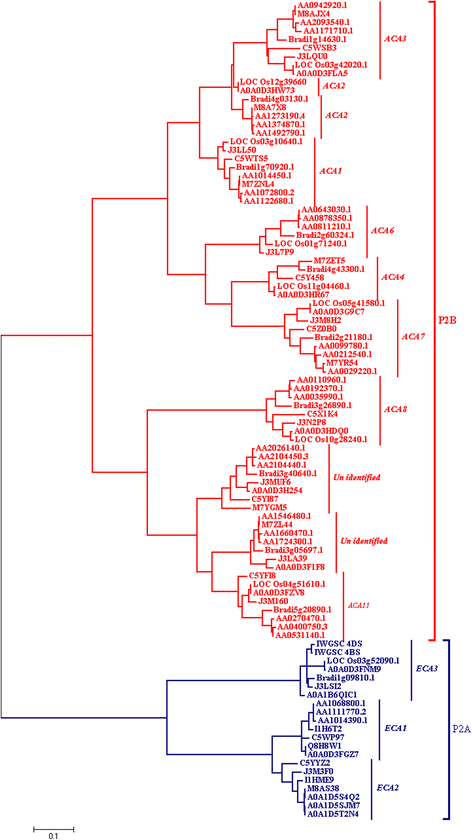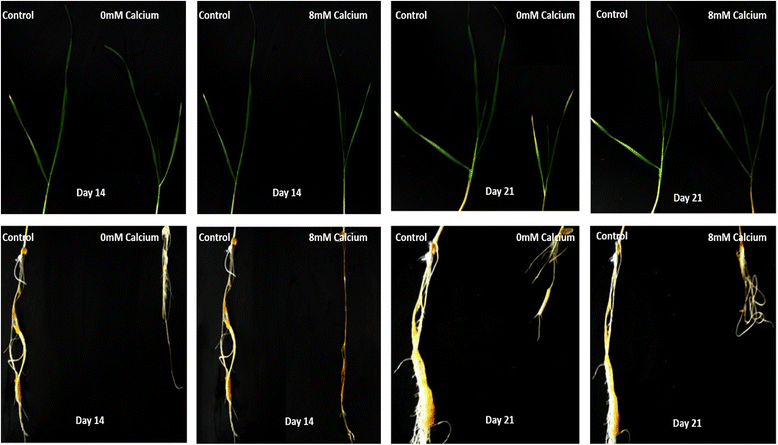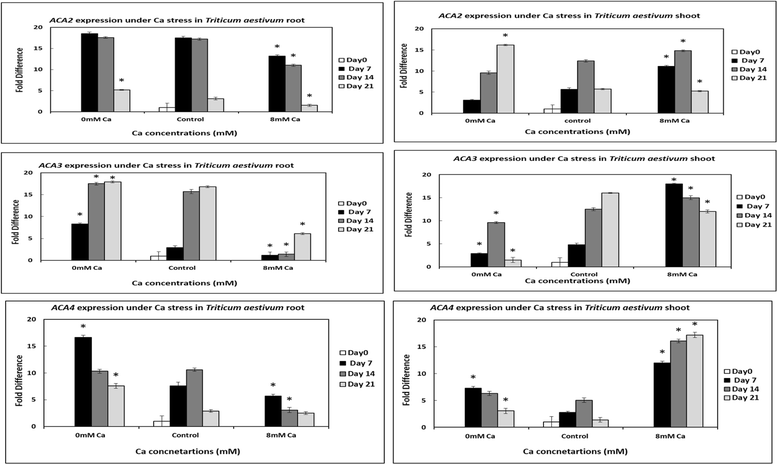Genome-wide analysis of wheat calcium ATPases and potential role of selected ACAs and ECAs in calcium stress
- PMID: 29078753
- PMCID: PMC5658947
- DOI: 10.1186/s12870-017-1112-5
Genome-wide analysis of wheat calcium ATPases and potential role of selected ACAs and ECAs in calcium stress
Abstract
Background: P2- type calcium ATPases (ACAs-auto inhibited calcium ATPases and ECAs-endoplasmic reticulum calcium ATPases) belong to the P- type ATPase family of active membrane transporters and are significantly involved in maintaining accurate levels of Ca2+, Mn2+ and Zn2+ in the cytosol as well as playing a very important role in stress signaling, stomatal opening and closing and pollen tube growth. Here we report the identification and possible role of some of these ATPases from wheat.
Results: In this study, ACA and ECA sequences of six species (belonging to Poaceae) were retrieved from different databases and a phylogenetic tree was constructed. A high degree of evolutionary relatedness was observed among P2 sequences characterized in this study. Members of the respective groups from different plant species were observed to fall under the same clade. This pattern highlights the common ancestry of P2- type calcium ATPases. Furthermore, qRT-PCR was used to analyse the expression of selected ACAs and ECAs from Triticum aestivum (wheat) under calcium toxicity and calcium deficiency. The data indicated that expression of ECAs is enhanced under calcium stress, suggesting possible roles of these ATPases in calcium homeostasis in wheat. Similarly, the expression of ACAs was significantly different in plants grown under calcium stress as compared to plants grown under control conditions. This gives clues to the role of ACAs in signal transduction during calcium stress in wheat.
Conclusion: Here we concluded that wheat genome consists of nine P2B and three P2A -type calcium ATPases. Moreover, gene loss events in wheat ancestors lead to the loss of a particular homoeolog of a gene in wheat. To elaborate the role of these wheat ATPases, qRT-PCR was performed. The results indicated that when plants are exposed to calcium stress, both P2A and P2B gene expression get enhanced. This further gives clues about the possible role of these ATPases in wheat in calcium management. These findings can be useful in future for genetic manipulations as well as in wheat genome annotation process.
Keywords: ACAs; Calcium; ECAs; P2- type; qRT-PCR.
Conflict of interest statement
Ethics approval and consent to participate
Dr. Alvina Gul Kazi from “Wheat Wide Crosses” lab at National Agriculture and Research Council (NARC) Pakistan identified and provided Wheat seeds (var. Sehar-06). Sehar-06 is a widely cultivated wheat variety in Pakistan.
Consent for publication
Not applicable.
Competing interests
The authors declare that they have no competing interests.
Publisher’s Note
Springer Nature remains neutral with regard to jurisdictional claims in published maps and institutional affiliations.
Figures





Similar articles
-
Molecular characterization and differential expression suggested diverse functions of P-type II Ca2+ATPases in Triticum aestivum L.BMC Genomics. 2018 May 23;19(1):389. doi: 10.1186/s12864-018-4792-9. BMC Genomics. 2018. PMID: 29792165 Free PMC article.
-
Genome-wide analysis of plant-type II Ca(2+)ATPases gene family from rice and Arabidopsis: potential role in abiotic stresses.Plant Physiol Biochem. 2013 Apr;65:32-47. doi: 10.1016/j.plaphy.2013.01.002. Epub 2013 Jan 30. Plant Physiol Biochem. 2013. PMID: 23416494
-
Genome-Wide Identification and Expression Analysis of ACA/ECAs in Capsicum annuum L.Int J Mol Sci. 2024 Nov 28;25(23):12822. doi: 10.3390/ijms252312822. Int J Mol Sci. 2024. PMID: 39684533 Free PMC article.
-
P-type calcium ATPases play important roles in biotic and abiotic stress signaling.Planta. 2024 Jun 26;260(2):37. doi: 10.1007/s00425-024-04462-7. Planta. 2024. PMID: 38922354 Review.
-
The role of P-type IIA and P-type IIB Ca2+-ATPases in plant development and growth.J Exp Bot. 2020 Feb 19;71(4):1239-1248. doi: 10.1093/jxb/erz521. J Exp Bot. 2020. PMID: 31740935 Review.
Cited by
-
Dissecting the relative contribution of ECA3 and group 8/9 cation diffusion facilitators to manganese homeostasis in Arabidopsis thaliana.Plant Direct. 2023 May 22;7(5):e495. doi: 10.1002/pld3.495. eCollection 2023 May. Plant Direct. 2023. PMID: 37228331 Free PMC article.
-
Genome-Wide Identification and Characterization of Banana Ca2+-ATPase Genes and Expression Analysis under Different Concentrations of Ca2+ Treatments.Int J Mol Sci. 2022 Oct 7;23(19):11914. doi: 10.3390/ijms231911914. Int J Mol Sci. 2022. PMID: 36233216 Free PMC article.
-
Dissecting the genetic control of natural variation in sorghum photosynthetic response to drought stress.J Exp Bot. 2022 May 23;73(10):3251-3267. doi: 10.1093/jxb/erab502. J Exp Bot. 2022. PMID: 34791180 Free PMC article.
-
Modulation of Ion Transport Across Plant Membranes by Polyamines: Understanding Specific Modes of Action Under Stress.Front Plant Sci. 2021 Jan 26;11:616077. doi: 10.3389/fpls.2020.616077. eCollection 2020. Front Plant Sci. 2021. PMID: 33574826 Free PMC article.
-
Saline-alkali stress tolerance is enhanced by MhPR1 in Malus halliana leaves as shown by transcriptomic analyses.Planta. 2022 Jul 29;256(3):51. doi: 10.1007/s00425-022-03940-0. Planta. 2022. PMID: 35906360
References
MeSH terms
Substances
LinkOut - more resources
Full Text Sources
Other Literature Sources
Miscellaneous

